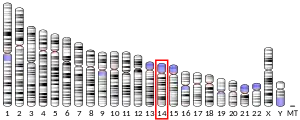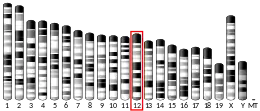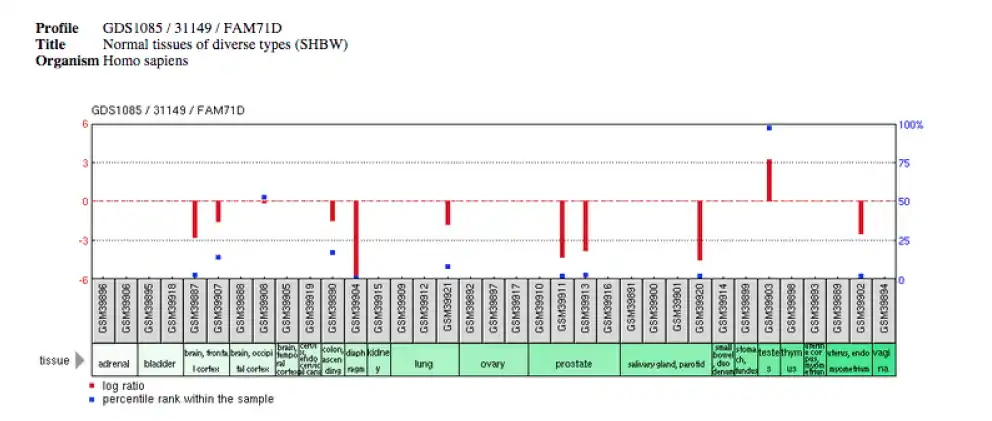FAM71D
FAM71D, also known as chromosome 14 open reading frame 54 (C14orf54), is a protein that in humans is encoded by the FAM71D gene on Chromosome 14.[5] Orthologs of FAM71D reach as far back in evolution to Reptiles, however, it is closer in homology to primates than any other orthologs. FAM71D has 6 paralogs: FAM71A, FAM71B, FAM71C, FAM71E1, FAM71F1, and FAM71F2[6] which encode a protein of unknown function.
| GARIN2 | |||||||||||||||||||||||||||||||||||||||||||||||||||
|---|---|---|---|---|---|---|---|---|---|---|---|---|---|---|---|---|---|---|---|---|---|---|---|---|---|---|---|---|---|---|---|---|---|---|---|---|---|---|---|---|---|---|---|---|---|---|---|---|---|---|---|
| Identifiers | |||||||||||||||||||||||||||||||||||||||||||||||||||
| Aliases | GARIN2, C14orf54, family with sequence similarity 71 member D, golgi associated RAB2 interactor family member 2, GARI-L1, FAM71D, GARI-L2 | ||||||||||||||||||||||||||||||||||||||||||||||||||
| External IDs | MGI: 1918147 HomoloGene: 49887 GeneCards: GARIN2 | ||||||||||||||||||||||||||||||||||||||||||||||||||
| |||||||||||||||||||||||||||||||||||||||||||||||||||
| |||||||||||||||||||||||||||||||||||||||||||||||||||
| |||||||||||||||||||||||||||||||||||||||||||||||||||
| |||||||||||||||||||||||||||||||||||||||||||||||||||
| Wikidata | |||||||||||||||||||||||||||||||||||||||||||||||||||
| |||||||||||||||||||||||||||||||||||||||||||||||||||
Gene
In humans, FAM71D is located at 14q23.3 and stretches between positions 67189393 and 67228550 (span 39157 bp).[7] It codes for at least 10 unique human protein isoforms: the primary isoform (422 aa; also denoted X1),[8][9][10][11] isoform X2 (417 aa),[12] isoform X3 (413 aa),[13] isoform X4 (400 aa),[14] isoform X5 (399 aa),[15] isoform X6 (398 aa),[16] isoform X7 (392 aa),[17][18] isoform X8 (389 aa),[19] isoform X9 (347 aa),[20] isoform X10 (336 aa)[21] In humans, FAM71D codes for an mRNA strand that is 1790 base pairs long. The human mRNA is composed of a 5' untranslated region that is 290 bases long and a 3' untranslated region that is 231 bases long[22] The gene has the following neighbours on the same chromosome:
- MPP5: MAGUK p55 subfamily member 5 plays a role in tumour suppression and receptor clustering
- GPHN: Gephyrin plays a role in anchoring inhibitory neurotransmitter receptors to postsynaptic cytoskeleton
- AT6V1D: V-type proton ATPase subunit D, an enzyme that mediates acidifcation of eukaryotic intracellular organelles
- SF3B44P1: Splicing Factor 3b, Subunit 4 Pseudogene 1
- LOC101927920: Probable Ribosome Biogenesis Protein RLP24-Like
- LOC105370538: Uncharacterized protein
- LOC105370541: Uncharacterized protein
Homology
| Genus and Species | Common Name | Accession Number | Seq. Length | Seq. Identity | Seq. Similarity |
| Pan troglodytes | Chimpanzee | XP_0011335797.2 | 422 a | 97% | 98% |
| Chlorocebus Sabaeus | Green Monkey | XP_007985246.1 | 422 a | 94% | 97% |
| Macaca mulatta | Rhesus macaque | XP_001102828.2 | 422 a | 94% | 96% |
| Camelus dromedarius | Dromedary | XP_5010975019.1 | 476 a | 70% | 81% |
| Vicogna pacos | Alpaca | XP_006207055.1 | 573 a | 70% | 80% |
| Bos taurus | Cattle | XP_010807832.1 | 400 a | 68% | 79% |
| Odobenus rosmarus divergens | Walrus | XP_004397632.1 | 412 a | 70% | 81% |
| Pteropus vampyrus | Large flying fox | XP_011384479.1 | 527 a | 73% | 80% |
| Felis catus | Cat | XP_011281587.1 | 398 a | 74% | 82% |
| Mus musculus | Mouse | NP_083345.1 | 440 a | 59% | 74% |
| Oryctolagus cuniculus | European rabbit | XP_008270069.1 | 397 a | 75% | 84% |
| Capra hircus | Goat | XP_005686047.1 | 397 a | 72% | 82% |
| Pantholops hodgsonii | Tibetan antelope | XP_005961615.1 | 397 a | 71% | 82% |
| Ornicus orca | Killer whale | XP_004262188.1 | 391 a | 72% | 81% |
| Tursiops trucatus | Bottlenose dolphin | XP_004322689.1 | 391 a | 72% | 81% |
| Phseter catodon | Sperm whale | XP_007119740.1 | 397 a | 72% | 82% |
| Equus caballus | Horse | XP_005605311.1 | 386 a | 69% | 79% |
| Ailuropoda melanoleuca | Giant panda | XP_0112304461.1 | 417 a | 71% | 81% |
| Fukomys demarensis | Dimaraland mole-rat | XP_010643626.1 | 412 a | 74% | 83% |
Protein
The primary protein encoded by FAM71D in humans is 422 amino acids long with a molecular weight of 47076 Da.[25] The protein is part of a functionally uncharacterized family of proteins (pfam 12480) with a domain of unknown function DUF3699.[26]
Structure
Several tools are available to predict the secondary structure of a protein. One tool that combines the results of few of them is PELE on SDSC Biology WorkBench.[27] According to this tool, the protein's secondary structure is mostly alpha helices, beta stands and coiled-coiled domains.
Post Translational Modifications
Like any other protein, this protein undergoes post-translational modifications. FAM71D is predicted to contain 2 nuclear export signals,[28] and lacks both a signal peptide[29] and transmembrane domains.[30]
Interactions
FAM71D interacts with PGK2,[31] TUBA3C,[31] and HSPB1.[32] FAM71D is also predicted to interact with the following proteins using STRING:[33]
- THUMPD3: THUMP domain containing 3
- CCDC170: Coiled-coil domain containing 170
- KLH10: Kelch-like 10
- TMEM48: Transmembrane protein 48
- SHCBP1L: SHC SH2-domain binding protein
- ASNA1: arsA arsenite transporter
- PPP1R16A: Protein Phosphate 1, regulatory subunit 16A
- IZUMO1: izumo sperm-egg fusion 1
- SF3B2: Splicing factor 3b, submit 2
- TUBB4B: Tubulin, beta 4B class IVb
Expression
FAM71D is primarily expressed in the testis of humans only expressed during the adult developmental stage.[34] GEO microarray data also supports the expression of FAM71D in humans[35]
Clinical Relevance
No studies have directly associated FAM71D protein with certain diseases. However, using NCBI GEO Profiles, FAM71D was found to be over-expressed in patients with unruptured intracranial aneurysms.
References
- GRCh38: Ensembl release 89: ENSG00000172717 - Ensembl, May 2017
- GRCm38: Ensembl release 89: ENSMUSG00000056987 - Ensembl, May 2017
- "Human PubMed Reference:". National Center for Biotechnology Information, U.S. National Library of Medicine.
- "Mouse PubMed Reference:". National Center for Biotechnology Information, U.S. National Library of Medicine.
- "NCBI Protein".
- "NCBI BLAST (National Center for Biotechnology Information)".
- "NCBI Gene".
- "NCBI Protein (National Center for Biotechnology Information)".
- "NCBI Protein (National Center for Biotechnology Information)".
- "NCBI Protein (National Center for Biotechnology Information)".
- "NCBI Protein (National Center for Biotechnology Information)".
- "NCBI Protein (National Center for Biotechnology Information)".
- "NCBI Protein (National Center for Biotechnology Information)".
- "NCBI Protein (National Center for Biotechnology Information)".
- "NCBI Protein (National Center for Biotechnology Information)".
- "NCBI Protein (National Center for Biotechnology Information)".
- "NCBI Protein (National Center for Biotechnology Information)".
- "NCBI Protein (National Center for Biotechnology Information)".
- "NCBI Protein (National Center for Biotechnology Information)".
- "NCBI Protein (National Center for Biotechnology Information)".
- "NCBI Protein (National Center for Biotechnology Information)".
- "NCBI Nucleotide (National Center for Biotechnology Information)". 4 May 2019.
- "NCBI Gene (National Center for Biotechnology Information)".
- "NCBI Blast (National Center for Biotechnology Information)".
- "PhosphositePlus".
- "NCBI Conserved Domains (National Center for Biotechnology Information)".
- "Biology Workbench".
- "CBS (Center of Biological Sequence Analysis)".
- "CBS (Center of Biological Sequence Analysis)".
- "CBS (Center of Biological Sequence Analysis)".
- "BioGrid3.3".
- "Mentha".
- "STRING 10".
- "NCBI UniGene (National Center for Biotechnology Information)".
- "NCBI UniGene (National Center for Biotechnology Information)".
- "NCBI Gene (National Center for Biotechnology Information)".
'





